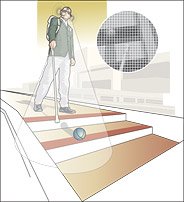Seeing With Your Ears
By ALISON MOTLUK
Published: December 11, 2005
Seeing is something that most of us expect to do with our eyes. But what
if you are born blind or lose your sight later in life? Peter Meijer
suggests you consider seeing with your ears instead.

Illustration by +ISM
A camera scans the visual field. The images are converted into a
soundscape by the computer. How the sounds might "look": a brightness
represented by volume; elevation is represented by pitch.
|
|
Meijer, a research scientist in the Netherlands, has developed a
technology called The vOICe, which allows you to represent visual
information - to "see" - with sounds. The device is a tiny camera, a
laptop and headphones. The camera is mounted on your head and the laptop
takes the video input and converts it into auditory information, or
soundscapes. The scene in front of you is scanned in stereo: you hear
objects on your left through your left ear and objects on your right
through your right ear. Brightness is translated as volume: bright things
are louder. Pitch tells you what's up and what's down. The image refreshes
once a second.
With practice, Meijer says, you can learn to sense instinctively how the
features of a soundscape correspond to objects in the physical world. Pat
Fletcher, for instance, a proficient user of The vOICe who could see until
age 21, describes the grayscale images in her head as "ghostly" but real.
At a meeting of the Cognitive Neuroscience Society in New York in April,
researchers from Harvard Medical School announced that when they viewed
the activity in the brains of two vOICe users (one blind at birth, the
other who went blind later in life), it was in many respects like that of
a sighted person while seeing.
Not everyone has the inclination to kit themselves out with a head-mounted
camera and a laptop. Fortunately, with the help of an enterprising
Bulgarian software company, Meijer has rejiggered his setup to work using
one of the most ubiquitous gadgets of our day: the camera phone. Now,
after downloading a simplified version of the software, practically anyone
can point her camera phone at what she wants to see and have a listen to
what it looks like.